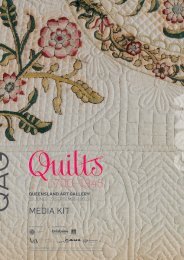sECONDARy sTUDENT WORKshEET - Queensland Art Gallery
sECONDARy sTUDENT WORKshEET - Queensland Art Gallery
sECONDARy sTUDENT WORKshEET - Queensland Art Gallery
Create successful ePaper yourself
Turn your PDF publications into a flip-book with our unique Google optimized e-Paper software.
Not as it seems . . .<br />
Look closely at the<br />
works by LN Tallur<br />
and Raqib Shaw.<br />
Why do you think<br />
they use glossy<br />
embellishments?<br />
Raqib Shaw / India/United Kingdom b.1974 / Paradise Lost 2001–11 / Oil, acrylic, glitter, enamel and rhinestones on birch wood / 300 x 900cm /<br />
© Raqib Shaw / Photograph: Ben Westoby / Image courtesy: The artist and White Cube, London<br />
Raqib Shaw | India/United Kingdom,<br />
b.1974<br />
Paradise Lost 2001–11<br />
<strong>Gallery</strong> 1.1, GOMA<br />
Raqib Shaw’s extravagantly detailed work<br />
Paradise Lost 2001–11 presents a nostalgic<br />
vision of Kashmir, once recognised as India’s<br />
‘paradise on earth’. The artist builds up surfaces<br />
with stained-glass paint and enamel, teasing<br />
them into shape using a porcupine quill.<br />
He finishes with gems, glitter and rhinestones<br />
to distract from the inherently dark themes.<br />
Years 8—12<br />
•<br />
Paradise Lost is also the title of a<br />
famous 1667 poem by John Milton<br />
about the moral decline of humanity.<br />
Why has the artist chosen this title?<br />
•<br />
Think about the cultural influences<br />
at work in society today. Are there<br />
characteristics specific to only one<br />
culture? Can you explain the reasons<br />
for this?<br />
Years 8—10<br />
•<br />
Do you have any cultural objects from<br />
the Pacific on display in your house?<br />
Were these bought for a decorative or<br />
cultural reason?<br />
•<br />
Does placing a mask from another<br />
culture in your home change the<br />
meaning of the object?<br />
Graham Fletcher / New Zealand b.1969 / Untitled (from ‘Lounge Room Tribalism’ series) (detail) 2010 /<br />
Oil on canvas / 162 x 130cm / Purchased 2010 with funds from the Estate of Lawrence F King in memory of the<br />
late Mr and Mrs SW King through the <strong>Queensland</strong> <strong>Art</strong> <strong>Gallery</strong> Foundation / Collection: <strong>Queensland</strong> <strong>Art</strong> <strong>Gallery</strong> /<br />
© The artist<br />
Graham Fletcher | New Zealand,<br />
b.1969<br />
Untitled (from ‘Lounge Room Tribalism’ series) 2010<br />
<strong>Gallery</strong> 1.1, GOMA<br />
Graham Fletcher explores how Pacific<br />
ethnographic material is collected and displayed<br />
in museums and private residences. His paintings<br />
place Pacific cultural objects in new contexts, in<br />
a way that questions the imposed categories of<br />
‘primitive’ and ‘non-primitive’ in Western society.<br />
Years 11—12<br />
•<br />
What does the term ‘aestheticised<br />
culture’ mean? How does this term<br />
relate to Graham Fletcher’s paintings?<br />
•<br />
Through the power of objects and<br />
their collections, museums and<br />
galleries display particular ideas,<br />
stories or truths. What do you think<br />
this work is saying about museums<br />
and galleries and their collections?

















